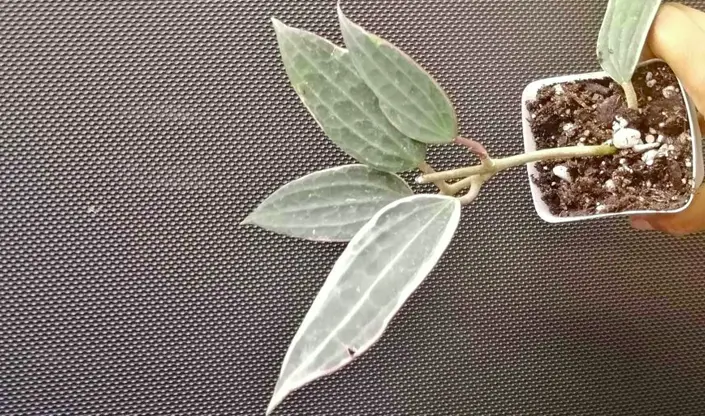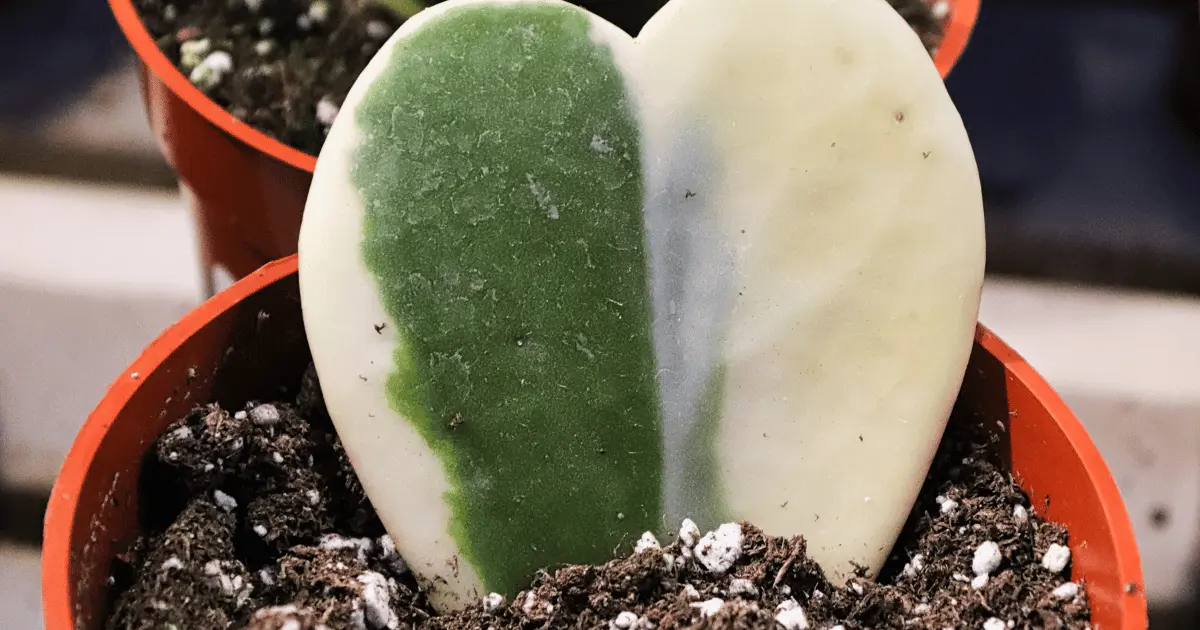When it comes to indoor plants, few breed the same admiration and awe as the variegated hoya. It’s a tropical ornamental, which unlike most of its counterparts, can’t be found outside greenhouses, and its foliage tends to be clusters and bright shades of green.
As a succulent, hoya care is similar to many other popular succulents like cacti. It’s a relatively easy-to-care-for plant, especially once established. Variegated hoya, however, offers some unique requirements that make it a valuable addition to any garden.
If you’ve always wanted to grow hoya plants, especially with variegation, then keep reading to get all the necessary tips.
The Variegated Hoya
Hoya is a genus of evergreen vines that hail from tropical and subtropical regions of Asia, while the variegated hoya (Hoya kerrii) is a species native to Vietnam. It can grow up to 3 meters in length as a climbing plant. The leaves of the variegated hoya are heart-shaped and have creamy white margins, and the flowers are small, white, and fragrant.

French botanist Pierre Edme Mariotte first described the variegated hoya in 1786, and it was introduced into Europe in 1884 by Scottish botanist Robert Fortune. The plant became popular in cultivation due to its attractive foliage and fragrant flowers. Today, the variegated hoya is widely grown as a houseplant. It can be tricky to keep alive, but it can thrive indoors with proper care.
Hoya Varieties
Most hoyas will do just fine in bright, indirect light, but a few will tolerate low-light conditions and make good houseplants. This is especially true of the variegated varieties. Here are some of the best hoya varieties:
- Hoya linearis – This variety is a beautiful plant with long, green leaves striped with white or cream. It can be a rampant grower, so keep an eye on it and prune it as necessary.
- Hoya carnosa ‘Variegata’ – This variety is a slow-growing Hoya with variegated leaves with creamy-white margins. It looks beautiful in a hanging basket where it can trail down.
- Hoya compacta’ Variegata’ – This hoya variety is another slow-grower with small, dark green leaves with creamy-white margins. The flower clusters mature into small, fragrant blooms as the plant matures.
- Hoya kerrii’ Variegata’ – This variety is probably the most well-known of the hoya varieties. It has heart-shaped leaves that are mottled green and white. As a fast-grower, it can quickly become pot-bound, repot as necessary.
- Hoya kentiana – This variety is particularly hard to come by, which makes them rare and expensive. It comprises glossy green leaves and thin elongated leaves.
Propagating Variegated Hoya
The most popular ways to grow variegated hoya are stem, leaf cuttings, layering, and seeds. However, the best ways to propagate hoya are through stem and leaf cuttings because they are cost-efficient and quite easy.
Stem Cutting
- Use a pair of sterile garden snips or scissors to cut the stem to avoid spreading disease. Remember to include a node or two.
- Leave a little stem below the bottom nodes to help secure your cutting in the potting material.
- Remove the foliage from the bottom node; here is where your new plant’s roots should develop.
- Once your cuttings are ready, you may root them in a jar of water without using root hormones.
- Place your cutting in a small jar of the moistened growth medium, with the bottom node near the soil surface. This will promote the emergence of new buds as well as root growth.
- Don’t allow the rooting medium to dry up while your stem cutting gains traction; keep it moist but not soggy. Within 3-4 weeks, roots should begin to develop, followed by new buds in roughly another three weeks.
- Pot up the stem cutting when the roots are an inch or two long. Begin by transplanting your rooted cuttings in a compact 2-inch or 4-inch container.
- After potting, keep the soil wet until the plant acclimates to its new environment, gradually reducing watering until your propagated plant is watered at the same regularity as its parent plant.
Leaf Cuttings
- Remove a handful of the parent plant’s lush, gorgeous green leaves off the stalk.
- Plant at least 5-6 leaves in the dirt, slightly covering the tops so roots may grow.
- Arrange the leaves in the container so the roots can spread as they develop.
- Water your plant till the roots emerge.
How to Care for Variegated Hoya
You should ensure to water your variegated hoya when the soil gets dry, especially during the growing season, and fertilize monthly. Ensure that it is in a bright place, but out of direct sunlight, as too much sunlight will scorch the leaves. To encourage blooming, give your plant 12 hours of complete darkness each night by covering it with a box or placing it in a closet.
Ways to Give Your Variegated Hoya a Cool Drink
Ensure your variegated hoya has a cool drink on hot days to keep it alive. To do that, try these methods:
Set up a drip system:
A simple way to give your hoya a cool drink is to set up a drip system. All you need is a water bottle with a small bottom hole and some tubing. Place the bottle upside down in your plant pot, and thread the tubing through the hole. Run the other end of the tubing into another pot or container filled with water. This will allow a slow, steady water drip to reach your plant.
Use ice cubes:
Another easy way to give your hoya a cool drink is to use ice cubes! Place one or two cubes in your plant pot, and let them melt into the soil. Your plant will love the extra moisture, and the cooler temperature will help it stay healthy during hot weather.
Mist regularly:
Misting your hoya with water is another great way to keep it cool and hydrated during summertime heat waves. If you do this, you should do it sparingly, as too much water will harm your plants.
Repotting a Variegated Hoya

The frequency with which you’ll need to repot your variegated hoya will depend on a few factors, including the size of your plant and the type of potting mix you’re using. If you’re using a high-quality potting mix that drains well, you can probably get away with repotting every other year or so. On the other hand, if you’re using a cheaper potting mix that doesn’t drain as well, you may need to repot your plant every year.
When it’s time to repot your variegated hoya, choose a pot that is only one size larger than the current pot. Be sure to use a terra cotta or plastic pot rather than a metal one, as metal pots can get very hot in the sun and damage your plant. In addition, use a pot with drainage holes to prevent waterlogging.
To repot your variegated hoya, gently remove it from its current pot. Then, tease out the roots and remove any old, dead leaves or stems. Next, add some fresh potting mix to the new pot and place your plant in it. Firmly press the new mix around the roots and water thoroughly. Lastly, place your plant in a bright spot from direct sunlight until it adjusts to its new home.
Pests and Diseases of Variegated Hoya
Pests and diseases are common problems for most plants, and variegated hoya is no exception. Some of the most common pests that affect this plant include mealybugs, aphids, and scale insects. These insects attack the plant foliage and suck out the sap, causing them to turn yellow and eventually fall off. If you notice these critters on your plant, carefully remove them by hand or treat them with insecticidal soap.
A few diseases can affect variegated hoyas, such as campus wilt, root rot, and leaf spot. Campus wilt is a fungal disease that attacks the plant roots, causing them to rot, while root rot is another fungal disease that spreads to the stem and leaves after affecting the plant’s roots. Leaf spot is a bacterial disease that causes brown or black spots on the plant’s leaves. If left unchecked, this can cause the leaves to fall off prematurely.
Where to Buy Variegated Hoya
Buying variegated hoya is easy since there are several places to get it. You can find them at your local nursery or garden center, or you can order them online from a variety of sources. Your best bet is to find a reputable source specializing in selling hoyas. This way, you can be sure that you’re getting a healthy plant that will thrive in your home.
When ordering online, research to ensure that the seller is reputable and has a good track record. Read customer reviews and ask questions if you need clarification on anything. When you’ve found a few good sources for variegated hoyas, compare prices and pick the one that matches your budget.
Remember that these plants can be expensive, so feel free to spend a little extra to get a high-quality plant.
The variegated hoya is worth considering if you’re looking for a beautiful, low-maintenance houseplant. With its variety of colors and shapes, finding one that fits your home won’t be a problem. And with just a little care, you can keep them happy and healthy for years.
